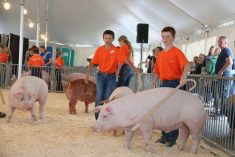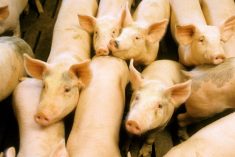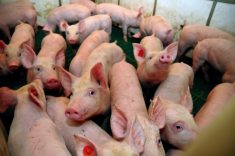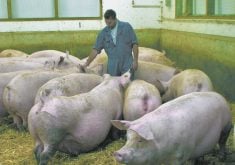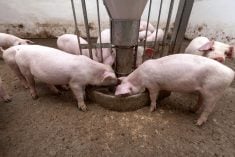A new-to-Canada soymeal product uses water to remove the anti-nutritional factors found in soybean meal.
Protekta is the Canadian distributor for a new soy-protein concentrate called AX-3 Advanced for piglets in creep, first and second stages of nursery diets. The feed should improve protein absorption by piglets and help reduce the use of zinc oxide, which has environmental concerns.
Why it matters: The water extraction removes the anti-nutritional factors, while other products on the market use heat to suppress these factors within the feedstuff.
Read Also

Ontario’s agri-food sector sets sights on future with Agri-Food 2050 initiative
The first-ever Agri Food 2050, a one-day industry event dedicated to envisioning the future of food and farming in Ontario,…
Through the process of water extraction, the trypsin inhibitor, beta conglycib, stachyose, and raffinose are removed, creating a molasses stream byproduct containing these anti-nutritional factors, which is sold into the bio-gas industry and for insect feeding.
“If you feed regular soybean meal to a small animal, any small animal, without treating, it causes some diarrhea or wet litter,” says Roger Smith, business development and territory manager with Protekta. “As the animal matures, so does the digestive tract, and they can offset the trypsin inhibitor issues. But small animals have a limited amount of hydrochloric acid production that helps to digest protein.”
AX3 Advanced helps to bring protein to the piglets’ diet, while respecting the acid binding capacity and migrates away from the use of zinc oxide, says Smith.
“In Europe, zinc oxide addition is going to be excluded come 2022, and places across Canada are trying to look at alternatives in ways to mitigate high zinc usage. I suspect the government here at some point will follow Europe’s lead and restrict zinc oxide use, so you better find a way to survive without it.”
The product was first launched earlier this summer at the Alberta and Ontario Pork Congresses.
Smith discovered the product, which was developed by the University of Copenhagen, while touring a feed mill in Denmark, and was intrigued by the low acid binding capacity.
“(The current feed used) has this large acid binding capacity and we neutralize a lot of the hydrochloric acid. Hydrochloric acid has to buffer off a lot of the minerals before the hydrochloric acid can stimulate pepsin for protein digestion. So if you can use a product that respects the acid binding capacity of the diet, you can get a better protein digestion, etc.”
As the piglet matures, so does the gut’s ability to handle the anti-nutritional factors, so the product should not be fed to piglets beyond 15 kilograms in size.
For more information, visit Protekta.com or a local feed mill.





